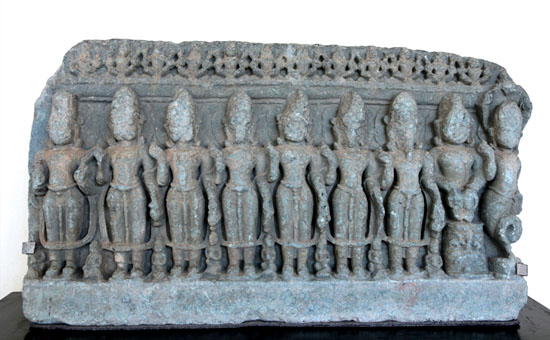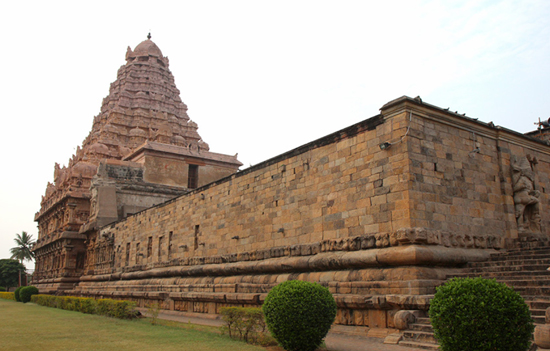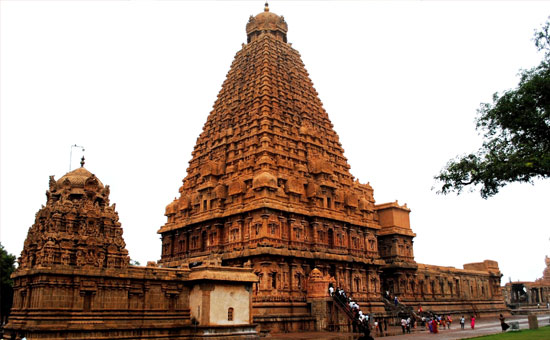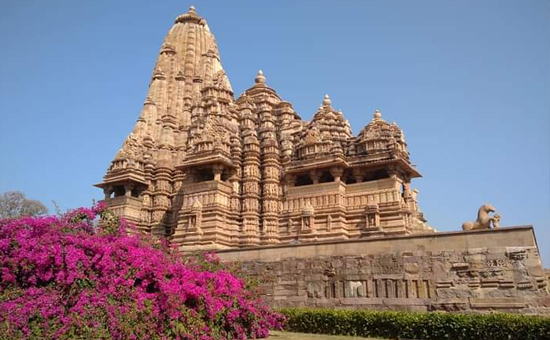- What is the
deeper spiritual purpose about a temple? What are components of a temple?
What is a deva? How is a deva
different from God as is known in Abrahamic faiths? What is a devālayam
(temple)? What are its components?
Vismāyā – issue at hand
In Bhārat, temples are generally viewed as public spaces where people go to pray, but is that a temple is? What is the raison d’etre of a temple? Why did the people of Bhārat build temples? What is its role in Bhārat’s culture (saṃskṛti)?
Traditionally, these questions have been viewed through
a Western prism. Consequently, even many who follow sanatana-dharma
often view devālayams as some sort of church or mosque where people go
to pray to a God, when in reality, these magnificent locations are actually centers
of cognitive awareness (prajñā).
PURVA-PAKSHA – Introduction to the solution/background
God in the Abrahamic faith is an eternal, omnipresent, omniscient creator and preserver of everything in the Universe. The worshipper has to accept this as fact and is not allowed to question this foundational paradigm, so it’s called a faith.
Also read What
is the concept of God in Christianity and Sanatana Dharma
The dharmic system of Bhārat’s
civilisation (raṣṭra) is a
practice that seeks Truth (satyam). Here, the Truth (paramarth-sathya or absolute
Truth) is called Brahman, a cognitive state of absolute, unchanging,
infinite peace, one that is found in the cognitive state of null (śūnya).
From the Brahman, also called nirguṇa-Brahman, materiality
manifests as maya or saguṇa-Brahman (Brahman with attributes or guṇa),
what we all cognise as creation.
What this means is that all creation (birth),
existence and dissolution (death) is a cognitive experience (maya) which
needs to be transcended in order to merge with the Brahman, also called
liberation (mokṣa). Otherwise, the individual will be wallowing is a
circle of life and death, called saṃsāra.
This is where the role of the deity (deva)
and the temple (devālayam) becomes relevant.
SIDDHANTA – Theory and arguments/solution and concept/doctrine
Śri Kṛṣṇa defines deva
in Śrīmad-bhagavadgita, chapter
18 (verse 14 and 15) where he
indicates that every aspect of creation/ existence is related to action (karma)
and all actions comprises the following components in gross (sthūla) as well as subtle (sūkṣma)
states.
Śrī Kṛṣṇa explains the five gross (sthūla) components
of any act as,
1. Adhiṣṭhāna – place or body – this is any place where action is being performed, within or outside the place/ body or kṣetra.
2. Karta – the doer. The doer/team/society/country/ entity is directly responsible for the action and its consequences.
3. Kāraṇa – causation or reason – reason for the action (mission, strategy and tactics).
4. Pṛithak-cheṣhṭāḥ – discrete aspect – all actions follow a hierarchy from the visible or apparent to that which is subtle, such as stages, sub-systems, micro-processes or component level delineation.
5. Devam - deity – all action is personified by a deity (deva), this means that every
action gets an identity (puruṣa) by its very existence. The deva is similar
to a brand but more subtle and complex, covering every imaginable aspect of
action and its cognition. For example, a bar of soap is just a product, but
when it is wrapped specially and given a name, it gets an identity like
Lifebuoy or Lux.
The deva
also covers the below mentioned subtle aspects of action by personifying it as
an independent manifestation with its own identity (asmita).
Subtle (sūkṣma) components of action
consist of three aspects (samgraha);
Karmachodanā – motivators of action comprising of three sub-elements;
1. Jñānam – wisdom – knowledge of the subject, including integration of resources and processes.
2. Jñeyam – the unknown aspects of the action such as various assumptions and forecast.
3. Parijñānata – decision-making based on evidence or acquisition of wisdom.
Action (karma) – The action itself must be aligned to the above components. If a person were to act differently, then the outcome would be completely different from plan, resulting in pain, grief as well as disappointment.
Karta – action of a doer as an individual or team member. In case a team is acting, then this covers the team as a unit also.
So, it can be seen that the deva is not a
static but a dynamic entity that gets created whenever action is performed,
becoming its personification, hence having infinite identities.
Schools of
worship
Guru Adi Sankara classified six major schools of
worship (shan-matha-bodham), these being śaivam
(worship of Siva), śaktyam (worship of Śakti), vaiṣṇavam (worship
of Vishnu), śauryam (worship of Soorya or
Sun), gaṇapāṭyam (worship of Gaṇeśa) and kaumāram (worship of
Kumāra or Karthik).
 Navagrahas (800-900 A.D.) around Eklinghji Mandir near Udaipur. Planets are traditionally carved on rectangular blocks.
Navagrahas (800-900 A.D.) around Eklinghji Mandir near Udaipur. Planets are traditionally carved on rectangular blocks.
Furthermore, in addition to the above major
schools, there are multiple smaller deities. For example, embedded in śauryam
is worship of nava-graha (nine planets) in the form or Sun (sūrya), Moon (soma), Mars (maṅgala), Mercury (budha), Jupiter
(guru/ bṛhaspati), Venus (śukra), Saturn (śani), Solar-node (rāhu) and Lunar-node (ketú). Actually, rāhu and ketú have no
real Western equivalence, the above expression is for convenience only.
When a devata is associated with a clan or
family, this deity is called kula-devata
(deity that looks after the well-being of the clan). Here,
the deity becomes a family member and participates in all major family events.
Next, the devata that looks after the
village is called a grāma-devatā.
Often, but not always, kula-devata (family-deity) and grāma-devatā
(village-deity) are the same for a family. It is also possible for a village to
have multiple grāma-devatās. The grāma-devatā
represents the identity of the village.
A personal deity, which is supposed to stay with
the individual is called ishta-devatā
(preferred-deity). This is a deity with whom the person has a sublime and
personal relationship. This devata can be any of the above, or even a deity
that is crafted personally by the individual.
The Temple (devālayam)
The temple (devālayam) is a living entity with its own identity, so it
must be treated like any living entity.
Since the temple is a living organism, it has a kṣetra (field
of activity) and an awareness of identity that defines it (kṣetrajña) and its
own motility (prāṇa). Its presence
in the locality is called prāsāda (castle) and the temple represents
the primordial experience or identity (puruṣa).
Since it is a living entity, the
deity is looked
after like people with normal needs such as sleep, ablutions, food etc.
Additionally,
the temple mirrors the identity of all that come to it and develops a
unique identity over time due to its association with its worshippers (pūjak).
Though temples may vary in size and worship, but
all would have a central deity which defines their identity.
This principle of puruṣa, prāṇa and panchabhūta
defines the structure as well as operation of any temple.
Temple location (vāstu-vinyāsa) – Bhāratiya
temples are constructed according to vāstu-śāstra and āgama principles.
To
begin, specific type of land chosen for the temple and this area is cleared of
debris, refuse, animal parts etc.
Temple layout (vāstu-puruṣa-mandala) – The temple layout is then decided depending on the identity of the main deity. Generally, square or rectangular are considered best. This area is then marked according to the vāstu-puruṣa-mandala.
Parts of a
temple
1. Garbhagraha – garbha means uterus or womb. Graha
is a cognate of grab or hold. So, it can be interpreted that garbhagraha means “that which holds creation”. This is the Brahman or source. Creation emerges from Brahman in
the material form (saguṇa-brahman). Materiality is a combination of
the primordial elements (panchabhūta) with motility (prāṇa). To signify this, the garbhagraha is always
kept enclosed space (earth or prithvi + space or ākāṣa, damp (áp or water), with a lit lamp all
the time (agni or fire + air or vāyu) in the garbhagraha.
The deity (pratimā =
image) is a saguṇa (material) manifestation or copy
of the Brahman and worshipping it is meant to assist a person in merging
with the deity and attaining mokṣa. The deity is called pratima because
it is a manifestation of primordial consciousness (Brahman) and because
it mirrors the image that the worshipper (pūjak).
The foundation of the vigraha / pratima,
which represents Brahman is set-up in a manner that signifies evolution of
materiality or sa-guṇa-brahman and praṇa called ṣaḍ-ādhāra-pratiṣṭhā.
The superstructure above the garbhagraha is
called śikhara in North India and vimana in South India, vesara in Central India and deul in Odisha. Vimāna/ śikhāra/ deul towers are topped by a kalash/ kumbh or pot
which represents the state of kumbaka in prāṇāyāma or the
state of null.
 Gangaikondacholapuram
Temple, Tamil Nadu. Notice plinth, antarala etc.
Gangaikondacholapuram
Temple, Tamil Nadu. Notice plinth, antarala etc.
2. Devalayam
Given below are the structures that one would
generally find in all traditional temples going outward from the garbhagraha.
a. Pitha – This is the plinth on which the entire temple is built.
b. Antarāla – this is the entry/ exit to the garbhagraha, often a vestibule to depict a uterus. It may be long
or short, depending on the temple design.
c. Ardhamandapam – this is a small inner chamber where prayer material is collated and pūjā preparation is done. Since
this place can be busy, worshippers (pūjak) are often not allowed in
this area.
d. Mahāmandapam
– this is the area from where people are expected to worship the deity.
e. Prahāra or pradakshina-patha
(circumambulation
or walkway) is the area surrounding the main garbhagraha, ardhamandapam
and mahāmandapam. This open walkway allows pūjak to
circumnavigate the garbhagraha clockwise and move towards the exit. There
can be multiple prahāras depending on the
size of the temple.
f. Koshta-vigrahās allow the pūjak to
gather intimate details of the deva and are classified as dakshina-koshtā
(southern window), uttara-koshtā (northern window) and paschima-koshtā
(western window).
g. Dvajasthambam - The dvajasthambam or flagstaff is
available in all temples and is placed at the top of the prahāra between
the mahāmandapam and the entrance (gopuram).
The flag staff (dvajasthambam)
is the banner of the deity. Sitting on top of the dvajasthambam is the
vehicle (vāhana) of the deity. The dvajasthambam is used to
signify various functions and occasions in the temple for everyone in the
vicinity.
h. Balipīṭham – this is a raised pedestal, mainly found in South Indian temples. This point in the temple is where when a person is supposed to set aside all sense of Self (asmitā) or ashtadvargās (six impediments) and enter the temple precinct.
 Brihadesvara Temple, TN, South India.
Brihadesvara Temple, TN, South India.
 Kandariya Mahadev Mandir, Khajuraho, MP, North India. Pic by Dr P Mathur
Kandariya Mahadev Mandir, Khajuraho, MP, North India. Pic by Dr P Mathur
i. Gopuram/ toraṇa – South Indian style temples have an ornate spired entrance which is called a gopuram (as shown here). North Indian temple gates are called toraṇa.
j. Jagati – the enclosure within the temple walls is called jagati. This is the overall confines of the
temple compound and represents the saguṇa form of the puruṣa.
Samgati – threading of logic to form a cohesive and comprehensive argument/conclusion
The above precis merely airbrushes the value of the
temple (devālayam) to Bharat as a place (rājya) and
civilisation (rāṣṭra) as well as its impact Bharat’s culture (saṃskṛti)
and practices (sampradāya).
The above is an extract
from a detailed research paper. To access paper click on PDF
Author Vishwanath Iyer is a fourth generation yoga practitioner, researcher and writer. He manages a site, www.schoolofyoga.in where he strives to explain classical yoga using a contemporary framework without deviating from the principles laid down by Bharat's ṛṣis. He can be contacted at schoolofyoga.in@gmail.com or through his website. Unless stated article pictures by Sanjeev Nayyar.
Also read
1. Appreciating
Indian Temple Architecture
2. Space and Cosmology in Indian Temples – Angkor Watt
3. To read all
articles on Temples of India
4. To see over 4,000
pictures on temples of India
5. Worshipping the Navagrahas